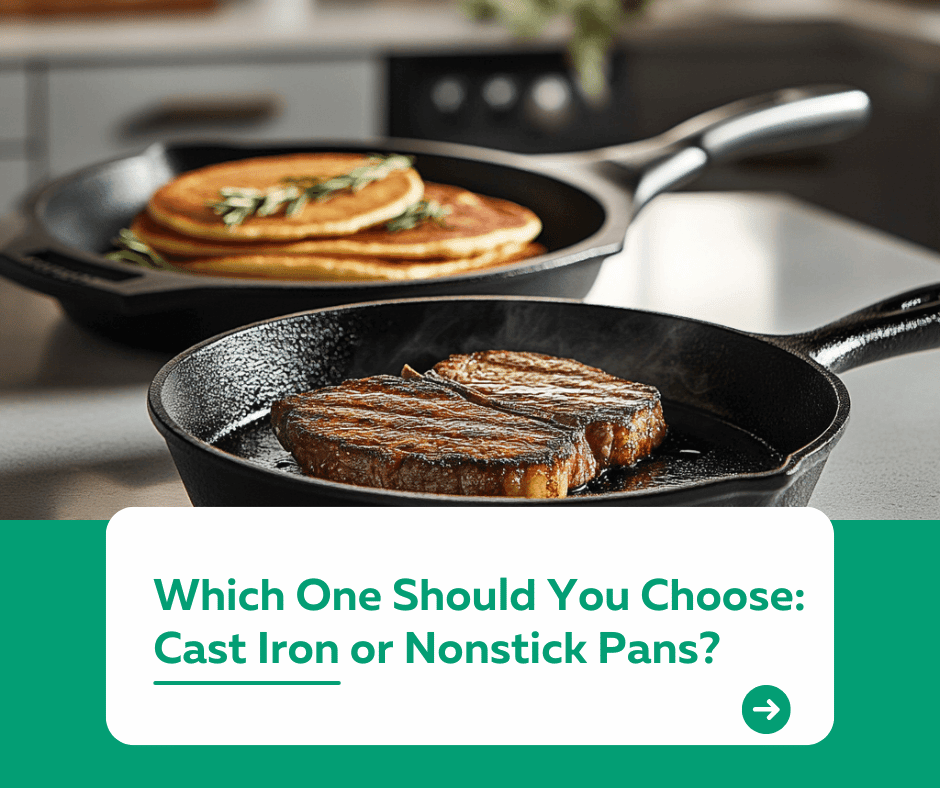
Introduction
Cooking pans are a kitchen essential, but the choice between cast iron and nonstick pans can be confusing. Which one is better for your cooking needs? Each has its pros and cons, depending on your style and preferences. Let’s explore the differences to help you decide.
1. Cast Iron Pans
Advantages
✅ Durability: Cast iron pans can last for decades with proper care.
✅ High Heat Retention: Perfect for searing, frying, and baking.
✅ Versatility: Works on stovetops, in ovens, and even over open flames.
✅ Naturally Nonstick: Develops a natural nonstick coating over time when seasoned.
Disadvantages
- Heavy: Can be cumbersome to handle, especially for beginners.
- Maintenance: Requires regular seasoning and careful cleaning to prevent rust.
- Takes Time to Heat: But retains heat for a long time once heated.
Best Uses
- Searing steaks, baking cornbread, frying chicken, and cooking over campfires.
2. Nonstick Pans
Advantages
✅ Ease of Use: Nonstick coating makes cooking and cleaning a breeze.
✅ Lightweight: Easy to handle and maneuver.
✅ Perfect for Delicate Foods: Ideal for eggs, pancakes, and fish.
Disadvantages
- Durability: Coating can wear off over time and is prone to scratching.
- Not Oven-Safe: Most nonstick pans have heat limits.
- Chemical Concerns: Some coatings may release harmful chemicals if overheated.
Best Uses
- Cooking eggs, pancakes, sautéing vegetables, and making light sauces.
3. Key Comparisons
| Feature | Cast Iron | Nonstick |
|---|---|---|
| Durability | Extremely durable and long-lasting | Coating wears over time |
| Ease of Cleaning | Requires careful cleaning and seasoning | Easy to clean, but delicate |
| Cooking Versatility | Great for high-heat and oven cooking | Best for low to medium heat |
| Weight | Heavy | Lightweight |
4. Which One Should You Choose?
Choose Cast Iron If:
- You enjoy cooking with high heat and need a versatile, long-lasting pan.
- You’re comfortable with the maintenance it requires.
- You want a pan that improves with use over time.
Choose Nonstick If:
- You prefer convenience and easy cleaning.
- You cook delicate dishes like eggs or pancakes regularly.
- You want a lightweight option for everyday cooking.
5. Caring for Your Pans
Cast Iron
- Clean with warm water and a soft sponge; avoid soap.
- Dry immediately and apply a thin layer of oil to prevent rust.
- Re-season regularly to maintain the nonstick surface.
Nonstick
- Use wooden or silicone utensils to avoid scratching the coating.
- Avoid high heat and the dishwasher to prolong its life.
- Replace when the coating starts to peel or wear off.
Conclusion
Both cast iron and nonstick pans have unique benefits, making them valuable additions to any kitchen. The choice comes down to your cooking habits and preferences. For long-lasting, versatile use, go with cast iron. For easy cleanup and quick meals, nonstick is the way to go.
For more kitchen insights, visit our Kuestion.com.